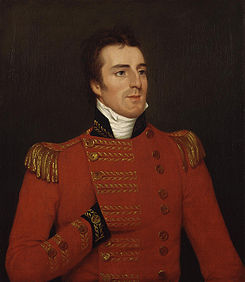Difference between revisions of "Duke of Wellington (NTW Character)"
Tango12345 (talk | contribs) m (Quick-adding category "NTW Historical Figures" (using HotCat)) |
|||
| Line 73: | Line 73: | ||
{{NTW Historical Figures}} | {{NTW Historical Figures}} | ||
| + | |||
| + | [[Category:NTW Historical Figures]] | ||
Revision as of 11:23, 29 May 2017
Arthur Wellesley, later, the Duke of Wellington was a Coalition Commander during the Napoleonic Wars
History
Arthur Wellesley was born in Ireland in the year 1769. He signed up for the British Army in 1787, serving as an Aide-de-Camp for two consecutive judiciaries of Ireland. Soon enough he left his home country and was assigned to the Netherlands with the 33rd Regiment to join the Duke of York in an invasion of France. He was promoted to a brigade command during the campaign and would take part in actions around Breda (prior to the Battle of Boxtel) and defending the Waal River. Despite this, the campaign concluded unsuccessfully, and in March 1795, Arthur Wellesley sailed back to England. Nonetheless, he had learned crucial lessons throughout his time in Flanders and these would inevitably be put to use in later life.
Although offered the position of Surveyor-General of the Ordnance by the new judiciary of Ireland (Lord Camden), he refused the post and soon returned back to his old regiment at Southampton, upon which he proceeded to sail to the West Indies. After seven weeks at sea, a storm forced them to turn back, but a few months later after a promotion to the rank of Colonel, Arthur Wellesley set out with the 33rd Regiment to Calcutta. After a few months in India, he went to the Philippines. War broke out however, in the form of british imperialism against Tippoo Sultan, in the Fourth Anglo-Mysore War. Arthur Wellesley performed with distinction throughout this, finally ending at the Battle of Srirangapatna and the subsequent assault on the fortress of Seringapatam. Upon the conclusion of the war, he assumed governorship of Mysore, reforming the justice and tax system within his province and hunting down rebels within the area.
In September 1802, Arthur Wellesley was promoted to Major-General, but with a new outbreak of hostilities was required to join the British forces in the Second Anglo-Maratha war. Acting decisively and impetuously, he was able to defeat the Marathas at Assaye (inflicting 6,000 casualties and deaths on the enemy, though at the expense of 1,584 of his own) and at Argaum was able to kill 5,000 enemy soldiers (at the expense of only 361 casualties of his own troops). His campaign in India taught Arthur about keeping his troops well disciplined, maintaining his logistics and the power of diplomacy.
In September 1804, after returning to England, Arthur Wellesley was made a Knight of the Bath. The next few years would involve him participating in the War of the Third Coalition in 1805, taking a brigade over the Elbe, taking part in the Second Battle of Copenhagen in August 1807 (on 30 September of the same year he would be promoted to Lieutenant-General) and in June 1808 would be dispatched to Portugal to take part in the Peninsular War.
Landing in Portugal in 1808 his arrival was at a crucial time. French Forces had already dominated Spain and were launching an invasion against Portugal. Wellesly and the Portuguese Generals constructed the forts of Lines of Torres Vedras keeping the French away from Lisbon. Then he worked with the reformed Portuguese army and Spanish guerrilas to drive the French from the Peninsula. He would command the Anglo-Portuguese army in Iberia until Napoleon's abdication in 1814 in wich the Peninsula finnaly became free again. Affter Napoleon's return from Elbe he commanded the British in the Battle of Waterloo in 1815, resulting in Napoleon's defeat and exile.
Significant Events
Ranks Held
- 7 March 1787 - Ensign (73rd Regiment of Foot)
- October 1787 - Aide-de-Camp (73rd Regiment of Foot)
- 25 December 1787 - Lieutenant (76th Regiment of Foot)
- June 1789 - Lieutenant (12th Light Dragoons)
- 1791 - Captain (18th Light Dragoons)
- 1793 - Major (33rd Regiment of Foot)
- September 1793 - Lieutenant Colonel (33rd Regiment of Foot)
- 1796 - Colonel (33rd Regiment of Foot)
- 1802 - Major General (33rd Regiment of Foot)
- 30 September 1807 - Lieutenant General
- 1814 - Field Marshal
